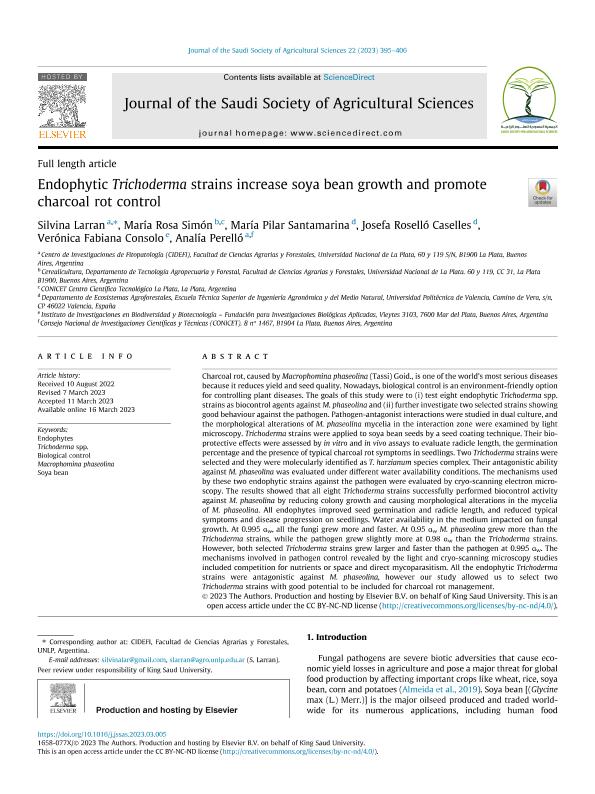Artículo
Endophytic Trichoderma strains increase soya bean growth and promote charcoal rot control
Larran, Silvina; Simon, Maria Rosa ; Santamarina, María Pilar; Roselló Caselles, Josefa; Consolo, Verónica Fabiana
; Santamarina, María Pilar; Roselló Caselles, Josefa; Consolo, Verónica Fabiana ; Perello, Analia Edith
; Perello, Analia Edith
 ; Santamarina, María Pilar; Roselló Caselles, Josefa; Consolo, Verónica Fabiana
; Santamarina, María Pilar; Roselló Caselles, Josefa; Consolo, Verónica Fabiana ; Perello, Analia Edith
; Perello, Analia Edith
Fecha de publicación:
03/2023
Editorial:
Elsevier
Revista:
Journal of the Saudi Society of Agricultural Sciences
ISSN:
1658-077X
Idioma:
Inglés
Tipo de recurso:
Artículo publicado
Clasificación temática:
Resumen
Charcoal rot, caused by Macrophomina phaseolina (Tassi) Goid., is one of the world's most serious diseases because it reduces yield and seed quality. Nowadays, biological control is an environment-friendly option for controlling plant diseases. The goals of this study were to (i) test eight endophytic Trichoderma spp. strains as biocontrol agents against M. phaseolina and (ii) further investigate two selected strains showing good behaviour against the pathogen. Pathogen-antagonist interactions were studied in dual culture, and the morphological alterations of M. phaseolina mycelia in the interaction zone were examined by light microscopy. Trichoderma strains were applied to soya bean seeds by a seed coating technique. Their bioprotective effects were assessed by in vitro and in vivo assays to evaluate radicle length, the germination percentage and the presence of typical charcoal rot symptoms in seedlings. Two Trichoderma strains were selected and they were molecularly identified as T. harzianum species complex. Their antagonistic ability against M. phaseolina was evaluated under different water availability conditions. The mechanisms used by these two endophytic strains against the pathogen were evaluated by cryo-scanning electron microscopy. The results showed that all eight Trichoderma strains successfully performed biocontrol activity against M. phaseolina by reducing colony growth and causing morphological alterations in the mycelia of M. phaseolina. All endophytes improved seed germination and radicle length, and reduced typical symptoms and disease progression on seedlings. Water availability in the medium impacted on fungal growth. At 0.995 ɑw, all the fungi grew more and faster. At 0.95 ɑw M. phaseolina grew more than the Trichoderma strains, while the pathogen grew slightly more at 0.98 ɑw than the Trichoderma strains. However, both selected Trichoderma strains grew larger and faster than the pathogen at 0.995 ɑw. The mechanisms involved in pathogen control revealed by the light and cryo-scanning microscopy studies included competition for nutrients or space and direct mycoparasitism. All the endophytic Trichoderma strains were antagonistic against M. phaseolina, however our study allowed us to select two Trichoderma strains with good potential to be included for charcoal rot management.
Archivos asociados
Licencia
Identificadores
Colecciones
Articulos(CCT - LA PLATA)
Articulos de CTRO.CIENTIFICO TECNOL.CONICET - LA PLATA
Articulos de CTRO.CIENTIFICO TECNOL.CONICET - LA PLATA
Articulos(INBIOTEC)
Articulos de INSTITUTO DE INV. EN BIODIVERSIDAD Y BIOTECNOLOGIA
Articulos de INSTITUTO DE INV. EN BIODIVERSIDAD Y BIOTECNOLOGIA
Citación
Larran, Silvina; Simon, Maria Rosa; Santamarina, María Pilar; Roselló Caselles, Josefa; Consolo, Verónica Fabiana; et al.; Endophytic Trichoderma strains increase soya bean growth and promote charcoal rot control; Elsevier; Journal of the Saudi Society of Agricultural Sciences; 22; 7; 3-2023; 395-406
Compartir
Altmétricas



